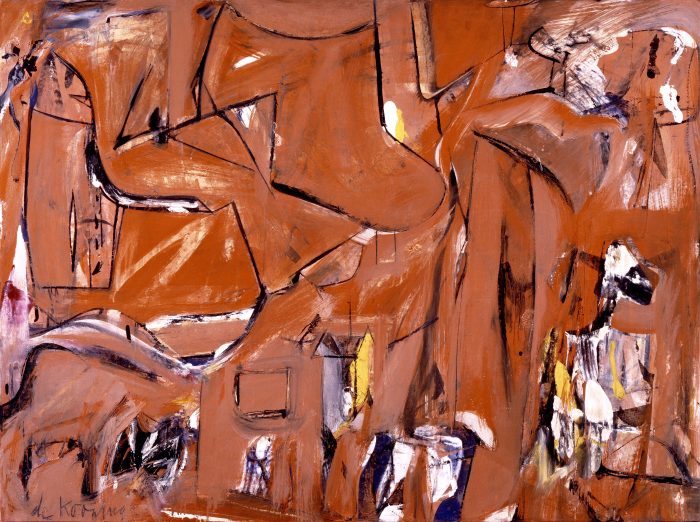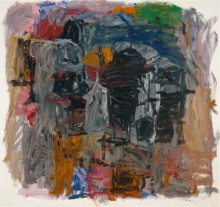Willem de Kooning
Gansevoort Street c. 1949

© 2019 The Willem de Kooning Foundation / Artists Rights Society (ARS), New York. Reproduction of this image, including downloading, is prohibited.
Willem de Kooning, who immigrated to the United States from the Netherlands in 1926, was one of the key artists involved in the development of American Abstract Expressionism as it evolved in New York in the 1940s and 1950s. During the mid- to late forties, do Kooning produced a group of paintings, many in black and white, that, although they contain definite references to the human body, are extremely complex combinations of biomorphic forms and paraphrased landscape details. The artist’s gestural use of line, executed rapidly yet confidently, resulted in ambiguous shapes that appear both partially representational and wholly abstract.
Gansevoort Street is one of a small group of paintings from this period that are exceptions to the artist’s engagement with black and white. The painting’s red-orange palette serves a distinct representational function. Running through the heart of New York’s bustling meat-packing district, the actual street named Gansevoort was then (as today) home to a variety of wholesale meat butchers and distributors. De Kooning’s expressive use of raw, fleshlike colors, therefore, forcefully transports the viewer into the neighborhood, the artist’s addition of white and black paint suggesting bones.
Although primarily a work of abstraction, traditional landscape elements can be detected throughout Gansevoort Street, particularly in the houselike form highlighted with yellow paint in the lower center of the painting and the slightly more abstracted structural form in the upper left corner. Like his other paintings from this period, Gansevoort Street is the product of de Kooning’s fascination with New York and his preoccupation with the visual stimuli that engulfed him during this walks through its streets. De Kooning would remark of his own strain of abstraction, provoked by the external materials that entered, sometimes arbitrarily, into his field of vision: “Everything that passes me I can see only a little of, but I am always looking. And I see an awful lot sometimes.”
– Molly Hutton, from the catalogue for the exhibition Celebrating Modern Art: Highlights of the Anderson Collection on view at the San Francisco Museum of Modern Art from Oct. 7, 2000 to January 15, 2001.
Friendships in the New York School
De Kooning is known for his use of bold lines in flux—employed expressively yet gesturally—to create portraits, biomorphic forms, and even landscapes. His line work creates a web of figures open to interpretation. The red background in Gansevoort Street is often associated with blood, as were the once-flourishing butcheries of the Meatpacking District in New York City, where the titular street is located. But does this painting go beyond raw and brutal bloodshed? Critic Terry R. Myers theorizes that the landscape abstractions in Gansevoort Street predict “the explosive urbanity soon to come” to the Meatpacking District. De Kooning’s bold lines bring the past and present of New York City together in one painting while also looking to the city’s future.
Upon moving to New York in 1926, de Kooning quickly became friends with Jackson Pollock, one of the leading Abstract Expressionists of the New York School. After the blossoming of this friendship, he began painting exclusively in black and white, influencing Franz Kline, the painter of Figure 8, to do the same. Look for color similarities with Lucifer and line similarities with Kline. Could this painting be a predecessor of Pollack and Kline’s later work?
—Irmak Ersoz ‘24







